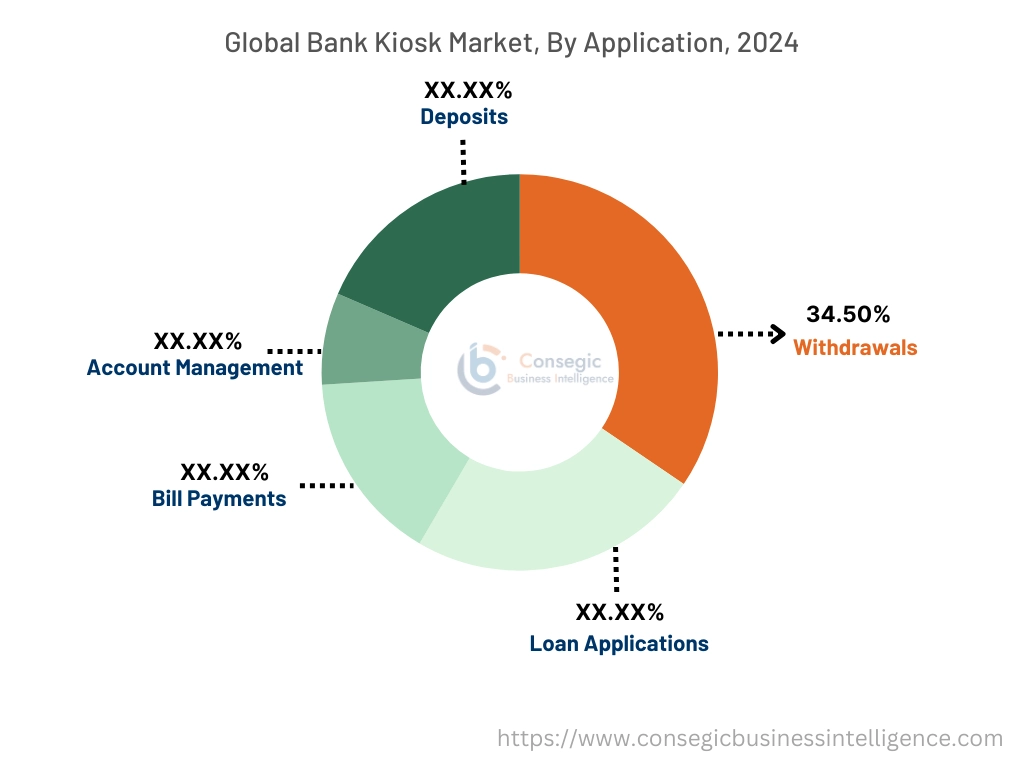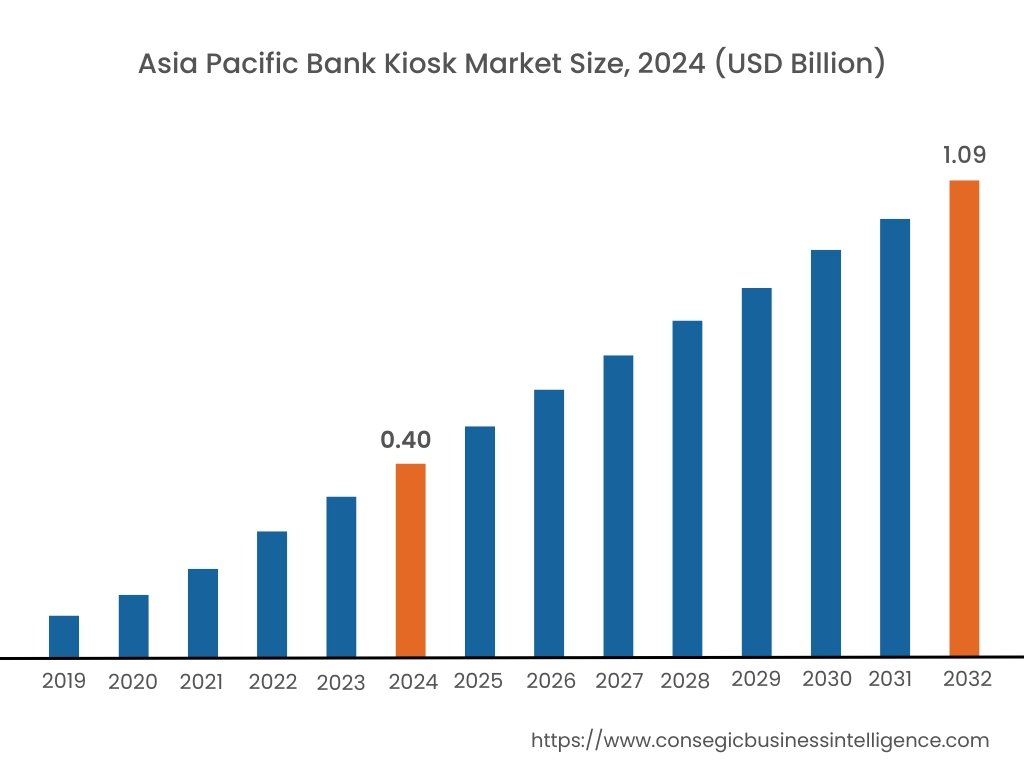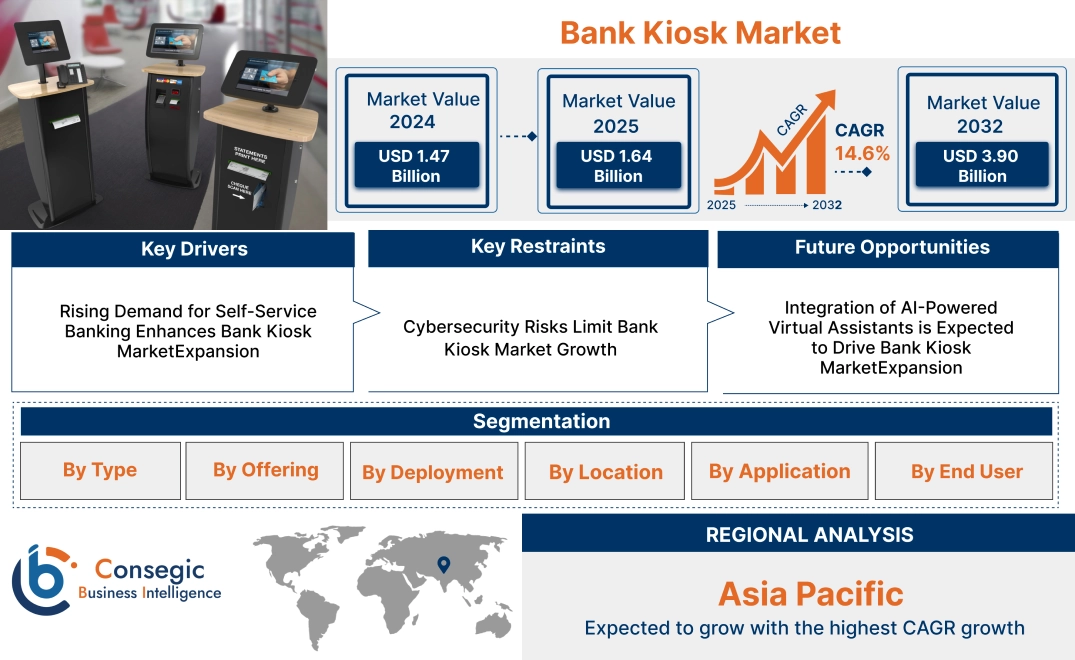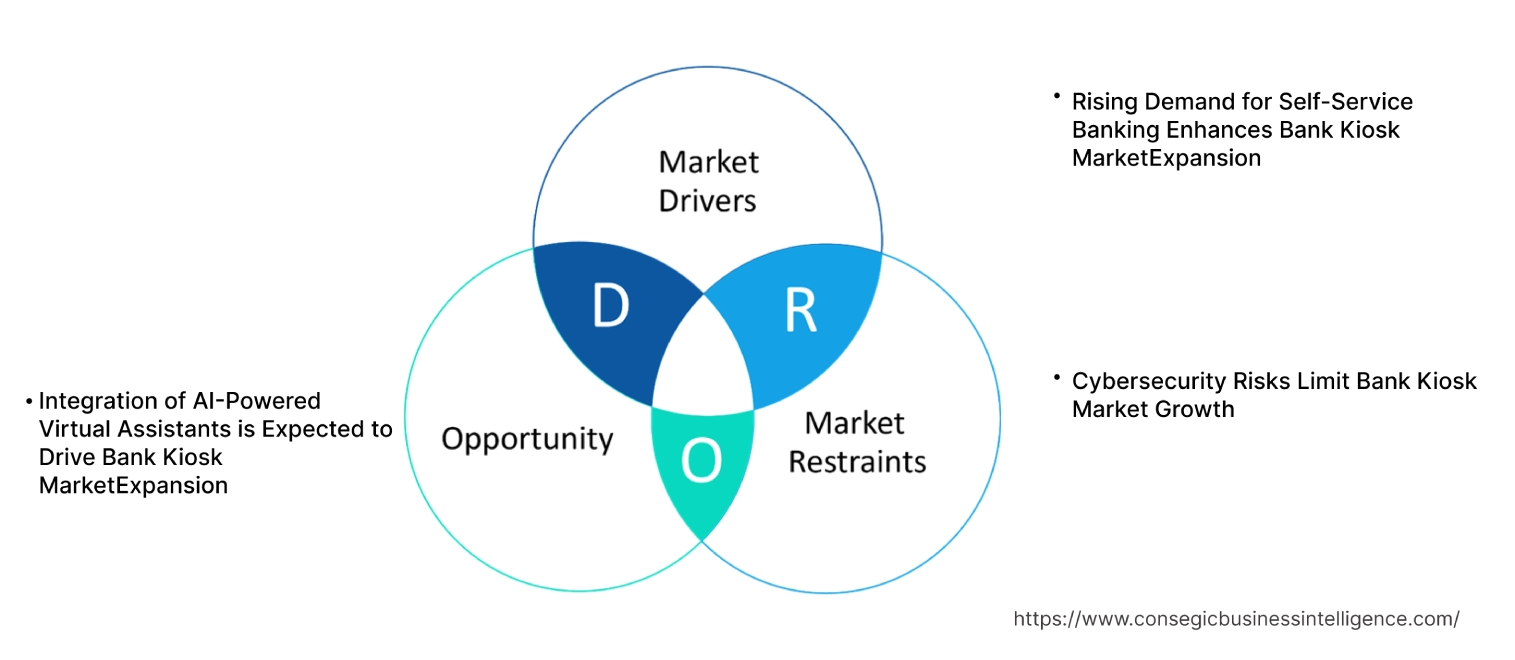- Summary
- Table Of Content
- Methodology
Bank Kiosk Market Size:
Bank Kiosk Market size is estimated to reach over USD 3.90 Billion by 2032 from a value of USD 1.47 Billion in 2024 and is projected to grow by USD 1.64 Billion in 2025, growing at a CAGR of 14.6% from 2025 to 2032.
Bank Kiosk Market Scope & Overview:
A bank kiosk is a self-service terminal that enables customers to perform banking transactions without human assistance. It provides services such as cash withdrawals, deposits, fund transfers, and account inquiries. These kiosks incorporate biometric authentication, touchscreen interfaces, and secure connectivity for seamless operations.
The key benefits of bank kiosks include reduced wait times, enhanced customer convenience, and 24/7 service availability. They optimize operational efficiency by minimizing manual intervention and reducing workload on bank staff. Advanced security features ensure safe transactions while improving accessibility for customers in remote locations.
Bank kiosks are widely used in retail banking, corporate banking, and financial institutions. They support functions like bill payments, loan applications, and check deposits. These self-service solutions enhance user experience by offering quick and efficient banking services in branches, malls, airports, and commercial centers.
Key Drivers:
Rising Demand for Self-Service Banking Enhances Bank Kiosk Market Expansion
Self-service banking solutions provide customers with efficient and convenient access to financial services without human intervention. Bank kiosks offer functionalities such as cash deposits, loan applications, and account inquiries, enhancing user experience. Many financial institutions are deploying these systems to reduce operational costs and improve service accessibility, particularly in high-footfall areas. For example, major banks have integrated interactive kiosks that enable customers to apply for loans and update personal details without visiting a branch. Therefore, the increasing preference for self-service banking solutions is enhancing the growth for bank kiosks.
Key Restraints:
Cybersecurity Risks Limit Bank Kiosk Market Growth
Bank kiosks handle sensitive financial data, making them vulnerable to cyber threats, hacking attempts, and data breaches. Unauthorized access to these kiosks could lead to financial fraud, identity theft, and operational disruptions. Financial institutions need to invest in robust cybersecurity measures, such as encryption and biometric authentication, to safeguard user data. However, implementing advanced security protocols increases operational costs, discouraging some banks from widespread kiosk growth. These cybersecurity risks and associated costs pose challenges, thereby limiting market expansion.
Future Opportunities :
Integration of AI-Powered Virtual Assistants is Expected to Drive Bank Kiosk Market Expansion
AI-powered virtual assistants will enhance the efficiency of bank kiosks by providing real-time assistance and personalized financial services. These smart kiosks will support voice recognition and natural language processing to guide customers through banking transactions. Leading banks are expected to adopt AI-driven kiosks to improve customer engagement and reduce wait times. For instance, future kiosk models will offer AI-based financial recommendations, streamlining loan approvals and investment consultations. Therefore, the integration of AI-powered virtual assistants is anticipated to create new bank kiosk market opportunities.
Bank Kiosk Market Segmental Analysis :
By Type:
Based on type, the bank kiosk market is segmented into single-function kiosks, multi-function kiosks, and virtual teller machines (VTMs).
The multi-function kiosks segment accounted for the largest revenue in bank kiosk market share in 2024.
- Multi-function kiosks offer a range of banking services such as deposits, withdrawals, loan applications, bill payments, and account inquiries in a single unit.
- These kiosks enhance efficiency by reducing customer wait times and operational costs for banks.
- Integration of biometric authentication, AI-powered interfaces, and machine learning algorithms is improving security and user experience.
- Banks are increasingly adopting multi-function kiosks to provide 24/7 access to banking services, especially in high-footfall areas.
- The trend for self-service banking solutions is leading to significant adoption of multi-function kiosks, particularly in digitally advanced regions.
- Therefore, according to bank kiosk market analysis, enhanced customer engagement through touch-screen interfaces, voice-guided navigation, and multi-language support is further fueling market expansion.
The virtual teller machines (VTMs) segment is anticipated to register the fastest CAGR during the forecast period.
- VTMs enable remote banking services with real-time video assistance from bank representatives, bridging the gap between physical and digital banking.
- They allow customers to complete complex transactions such as check cashing, loan inquiries, account verification, and document submission without visiting a physical branch.
- Growing trend of digital banking solutions and remote customer engagement is driving growth for VTMs, particularly among younger and tech-savvy customers.
- The integration of AI chatbots, automated teller features, and natural language processing (NLP) is further enhancing VTM capabilities.
- Increasing deployment of VTMs by financial institutions to improve service accessibility in both urban and semi-urban areas is contributing to market expansion.
- Thus, according to bank kiosk market analysis, enhanced cybersecurity measures, including encrypted transactions and biometric verification, are improving customer trust in VTMs.
By Offering:
Based on offering, the market is segmented into hardware, software, and services.
The hardware segment accounted for the largest revenue in bank kiosk market share in 2024.
- Hardware components include ATM-like machines, touchscreens, biometric scanners, card readers, cash dispensers, and encrypted PIN pads.
- Banks and financial institutions invest heavily in hardware infrastructure to expand self-service banking capabilities and reduce reliance on branch personnel.
- Technological advancements such as NFC-enabled kiosks, contactless payments, and QR code-based transactions enhance user convenience and security.
- Increased trend for cash recycling ATMs, anti-skimming security features, and weather-resistant kiosks is boosting hardware sales.
- Therefore, according to the market analysis, integration of interactive displays, digital signage, and augmented reality (AR) capabilities in kiosks is enhancing the overall customer experience.
The software segment is anticipated to register the fastest CAGR during the forecast period.
- Banking kiosk software enables secure transactions, user authentication, real-time banking service management, and predictive analytics for customer behavior insights.
- AI-driven software solutions are improving customer interaction through natural language processing (NLP), facial recognition, and machine learning-based fraud detection.
- Cloud-based kiosk software allows seamless integration with core banking systems for remote monitoring, updates, and real-time performance analytics.
- Banks are increasingly investing in software upgrades to enhance kiosk functionality, cybersecurity, and omnichannel integration with mobile and online banking platforms.
- Thus, according to the market analysis, personalized banking experiences, such as tailored product recommendations and dynamic user interfaces, are emerging as key trends in kiosk software development.
By Deployment:
Based on deployment, the market is segmented into on-site and off-site kiosks.
The on-site segment accounted for the largest revenue share in 2024.
- On-site kiosks are deployed within bank branches to streamline customer service, reduce operational workload, and improve transaction efficiency.
- They assist customers in conducting transactions without requiring direct interaction with bank staff, thus enhancing operational efficiency and cost-effectiveness.
- The growth of interactive kiosks in bank branches enhances customer satisfaction through features such as personalized service options, paperless transactions, and instant account updates.
- Therefore, according to the market analysis, advanced on-site kiosks equipped with AI-driven virtual assistants are transforming in-branch banking experiences.
The off-site segment is anticipated to register the fastest CAGR during the forecast period.
- Off-site kiosks are placed in high-traffic areas such as malls, airports, business centers, educational institutions, and transportation hubs for increased accessibility.
- Banks use off-site kiosks to expand their reach and cater to customers who prefer digital and remote banking solutions without the cost of maintaining full-service branches.
- The growing trend of branchless banking, increased mobile penetration, and the rise of digital-only banking services are accelerating off-site kiosk deployment.
- Thus, according to the market analysis, enhanced security measures, including real-time fraud detection, remote troubleshooting, and GPS tracking, are making off-site kiosks more viable for financial institutions.
By Location:
Based on location, the market is segmented into rural, semi-urban, urban, and metropolitan areas.
The urban segment accounted for the largest revenue share in 2024.
- Urban areas have a high density of banking customers, leading to increased growth for self-service kiosks that reduce congestion in branches.
- Banks deploy kiosks in urban centers to offer 24/7 banking services and cater to the growing bank kiosk market demand for digital financial transactions.
- Technological advancements such as biometric authentication, NFC payments, AI-powered chatbots, and blockchain-enabled transactions are enhancing kiosk trend in urban regions.
- Therefore, according to the market analysis, high smartphone penetration and increased awareness of digital banking solutions are contributing to the demand for urban banking kiosks.
The rural segment is anticipated to register the fastest CAGR during the forecast period.
- Governments and banks are focusing on financial inclusion, leading to increased deployment of kiosks in rural areas to serve unbanked and underbanked populations.
- Rural kiosks provide essential banking services, including cash deposits, withdrawals, microfinance services, and government scheme disbursements, where branch penetration is limited.
- Thus, according to the market analysis, the trend of mobile banking, digital transactions, and low-cost, solar-powered kiosks is boosting bank kiosk market demand for self-service banking solutions in rural locations.
By Application:
Based on application, the market is segmented into deposits, withdrawals, loan applications, bill payments, and account management.
The withdrawals segment accounted for the largest revenue share of 34.50% in 2024.
- Withdrawals remain the most common banking transaction, leading to high usage of cash-dispensing kiosks with real-time transaction processing capabilities.
- Banks deploy self-service kiosks to reduce teller workload, improve operational efficiency, and provide 24/7 cash withdrawal services.
- Therefore, according to the market analysis, advanced security features such as facial recognition, fingerprint scanning, and one-time PIN authentication enhance kiosk security for withdrawals.
The loan applications segment is anticipated to register the fastest CAGR during the forecast period.
- Kiosks enable customers to apply for loans with minimal paperwork, instant document scanning, and real-time assistance from AI-based advisors.
- AI-driven kiosks provide instant eligibility checks, customized loan offers, and digital contract signing capabilities.
- Thus, according to the market analysis, financial institutions are leveraging kiosks to enhance customer engagement, optimize loan processing, and accelerate credit approval timelines.

By End-User:
Based on end-user, the market is segmented into banks, credit unions, and building societies.
The banks segment accounted for the largest revenue share in 2024.
- Banks are the primary adopters of self-service kiosks, leveraging them to enhance customer service, reduce operational costs, and improve transaction efficiency.
- The deployment of kiosks in bank branches and off-site locations provides customers with round-the-clock access to essential banking services such as withdrawals, deposits, account inquiries, and bill payments.
- Integration of AI-powered chatbots, biometric authentication, and contactless transaction capabilities is transforming kiosk functionality in traditional banking institutions.
- Banks are utilizing kiosks to streamline loan applications, credit assessments, and personalized financial advisory services, increasing customer engagement.
- Therefore, according to the market analysis, the increasing preference for digital banking and self-service solutions among consumers is driving significant investments in bank-operated kiosk infrastructure.
The credit unions segment is anticipated to register the fastest CAGR during the forecast period.
- Credit unions are adopting self-service kiosks to expand their service reach, particularly in underserved and rural areas, without incurring high branch maintenance costs.
- Kiosks enhance member experience by providing fast, secure, and cost-effective banking solutions, including account management, loan servicing, and fund transfers.
- The integration of AI-based customer assistance and mobile app connectivity is improving kiosk functionality for credit union members.
- Thus, according to the market analysis, credit unions are leveraging kiosks to automate financial transactions while maintaining personalized customer service, increasing overall efficiency.
Regional Analysis:
The regions covered are North America, Europe, Asia Pacific, the Middle East and Africa, and Latin America.

Asia Pacific region was valued at USD 0.40 Billion in 2024. Moreover, it is projected to grow by USD 0.44 Billion in 2025 and reach over USD 1.09 Billion by 2032. Out of this, China accounted for the maximum revenue share of 29.88%. Asia-Pacific is experiencing increased adoption of bank kiosks due to rising financial inclusion initiatives and digital banking expansion. Countries like China, India, and Japan are deploying self-service kiosks to serve unbanked and underbanked populations. Government policies promoting cashless transactions and rapid urbanization contribute to market expansion. The presence of local and international banking institutions investing in automation further influences market performance.

In 2024, North America was valued at USD 0.49 Billion and is expected to reach USD 1.29 Billion in 2032. North America holds a significant share of the bank kiosk market due to high adoption of self-service banking solutions. The United States leads the region, with banks investing in digital transformation to enhance customer experience. The demand for secure and contactless banking transactions influences market expansion. The presence of major financial institutions and advanced technology providers supports market performance.
Europe has a well-established bank kiosk market, supported by stringent financial regulations and a strong focus on digital banking solutions. The United Kingdom, Germany, and France are key markets due to high adoption of self-service technologies. The emphasis on secure transactions and compliance with data protection laws impacts kiosk deployment strategies. Banks in the region are integrating biometric authentication and AI-driven functionalities to enhance customer engagement.
The Middle East and Africa are witnessing increased adoption of bank kiosks as financial institutions modernize banking infrastructure. Countries like the UAE and Saudi Arabia are investing in digital banking initiatives and contactless payment technologies. In Africa, financial inclusion programs and partnerships with fintech companies influence kiosk deployment. The expansion of mobile banking solutions also plays a role in shaping bank kiosk market trends.
Latin America is emerging as a potential market for bank kiosks due to the increasing growth for self-service banking in Brazil, Mexico, and Argentina. Banks are focusing on automation to reduce operational costs and improve customer service. The rise of digital banking and government efforts to enhance financial accessibility influence market performance. Public and private sector investments in smart banking technologies further contribute to kiosk deployment.
Top Key Players and Market Share Insights:
The global bank kiosk market is highly competitive with major players providing products and services to the national and international markets. Key players are adopting several strategies in research and development (r&d), product innovation, and end-user launches to hold a strong position in the global bank kiosk market. Key players in the bank kiosk industry include-
- Diebold Nixdorf, Incorporated (United States)
- NCR Corporation (United States)
- GRG Banking Equipment Co., Ltd. (China)
- Wincor Nixdorf (Germany)
- KIOSK Information Systems (United States)
- Hyosung TNS, Inc. (South Korea)
- Olea Kiosks, Inc. (United States)
- Meridian Kiosks (United States)
- Advanced Kiosks (United States)
- Zebra Medical Vision (Israel)
Recent Industry Developments :
Product Launches:
- In October 2024, Santander introduced its digital bank, Openbank, in the U.S. This initiative aims to reduce funding costs associated with vehicle loans and expand Santander's retail presence. Openbank offers competitive savings account yields to attract deposits, positioning itself as a significant player in the digital banking landscape.
Bank Kiosk Market Report Insights :
| Report Attributes | Report Details |
| Study Timeline | 2019-2032 |
| Market Size in 2032 | USD 3.90 Billion |
| CAGR (2025-2032) | 14.6% |
| By Type |
|
| By Offering |
|
| By Deployment |
|
| By Application |
|
| By End-User |
|
| By Region |
|
| Key Players |
|
| North America | U.S. Canada Mexico |
| Europe | U.K. Germany France Spain Italy Russia Benelux Rest of Europe |
| APAC | China South Korea Japan India Australia ASEAN Rest of Asia-Pacific |
| Middle East and Africa | GCC Turkey South Africa Rest of MEA |
| LATAM | Brazil Argentina Chile Rest of LATAM |
| Report Coverage |
|
Key Questions Answered in the Report
How big is the Bank Kiosk Market? +
In 2024, the Bank Kiosk Market was USD 1.47 Billion.
What will be the potential market valuation for the Bank Kiosk Market by 2032? +
In 2032, the market size of Bank Kiosk Market is expected to reach USD 3.90 Billion.
What are the segments covered in the Bank Kiosk Market report? +
The type, offering, location, deployment, application and end-user are the segments covered in this report.
Who are the major players in the Bank Kiosk Market? +
Diebold Nixdorf, Incorporated (United States), NCR Corporation (United States), GRG Banking Equipment Co., Ltd. (China), Wincor Nixdorf (Germany), KIOSK Information Systems (United States), Hyosung TNS, Inc. (South Korea), Olea Kiosks, Inc. (United States), Meridian Kiosks (United States), Advanced Kiosks (United States), Zebra Medical Vision (Israel) are the major players in the Bank Kiosk market.


